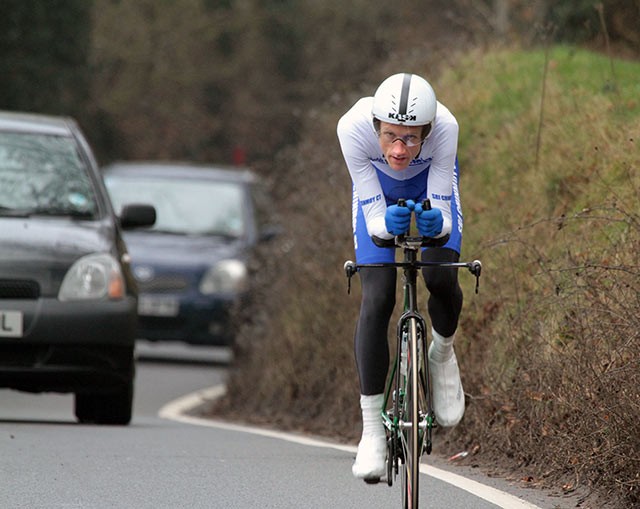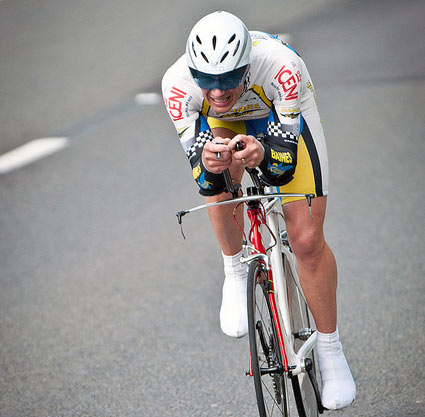In time trials aerodynamics are very important. Small changes in your body position can make a big difference to the drag you create and therefore has a big effect on your speed and time.
Professionals will spend hours in wind tunnels to refine their position, trying to gain small marginal gains. Even if you don’t have access to a wind tunnel, many people can improve their position, just by following some principles.

A few points worth bearing in mind
- Some positions may be very aerodynamic, but compromise power.
- Roughly 10% of aerodynamic drag is your bike. 90% is your body. So you might want to spend money on improving your position before a new bike!
- Aerodynamics is not just about air hitting you from the front, but how it leaves you afterwards.
- You might assume that going lower will improve your aerodynamic drag, but it doesn’t necessarily go faster.
- You can get some great ideas by looking at other riders who have spent time refining their position, but it is quite individual – depending on your body type. Some people like Chris Boardman could ride with a flat back, but others would struggle to get that position.
Michael Hutchinson (July 2010) then comp record holder for 10 mile TT (17.57) Michael Hutchinson at BTTC in 2010. Hutchinson was for many years, Britain’s top domestic time triallist.
Improving Position on Time Trial Bike
- The basic idea is to present the smallest frontal position to the wind.
- Note: there comes a point when lowering the tribars can start to decrease power because breathing is slightly restricted. It becomes a trade off between aerodynamics and power.
- In the picture above notice how much lower the tribars are compared to the saddle.
- The second most important thing is bringing in the arms. On a road bike they are about 42cm apart. But, using tribars you can bring the arms closer together and reduce the wind resistance. If you watch Tony Martin on a TT bike, his arms are almost touching. Be careful, if you bring your arms in too much, it can be more difficult to steer, but also may not even be more aerodynamic as it can push your shoulders out.
- See also: Tips to improve aerodynamics on bike

Me in British Time Trial Championship. This was not such a good aerodynamic position. When I came out of wind tunnel, I had reduced by head to leave less sticking into the wind.

Tribar – arm position

The UCI stipulate the tribars have to be in a flat horizontal position. If you try lift the tribars, most riders will find it more aerodynamic. When I was in a wind tunnel, lifting the hand position to be like a V, helped reduce aerodrag. It may not look more aerodynamic, but it was. If you ride CTT or triathlons, then it is worth experimenting with this aero position.
Graeme Obree – The Best Time Trial Position?
Note how low the head is up, but eyes are looking forward.
Graeme Obree in the Superman position. It is called the superman position because his arms are stretched out. Notice how flat the back is and hence how aerodynamic position
The Tuck Position
In this photo, Graeme Obree is showing another very aerodynamic position because his arms are tucked in like a skier. Graeme Obree was one of the world’s greatest time triallist. He was world champion twice and broke the world hour record twice. He was also an innovator, creating these unique riding positions. These positions were later banned by the UCI.
Time Trial Position and Wind Tunnel Testing
To try and gain optimal time trial position I went to a wind tunnel. This tested aerodynamic drag in various positions. This helped to find a position which considerably reduced aero drag. As a result, my times for time trials dropped.
See: Review of wind tunnel testing for time trial position
Time Trial Position and Power Output
When finding the optimal time trial position, it is not just aerodynamics that is important. Some positions may compromise your power output. However, there is also an element of getting used to positions. I do a lot of training on the time trial bike trying to hold a good position, so that when I race, I’m not suddenly straining my neck muscles.
It’s easy to get a very aerodynamic position for five minutes in the wind tunnel – it’s another matter holding it for 4 hours in a 100 mile TT.
Time Trial Position and Distance
For short time trials, it is possible to go for a more extreme position. For long time trials, it is more important to be comfortable. Also, your arms can be a conduit for reducing lactic acid in legs, therefore, it is important to keep them relaxed for long time trials to help reduce lactic acid in legs.
Time Trial Position UCI Legal
If you do UCI races, you have to keep to quite strict parameters about what is legal.
- Distance from vertical line of bottom bracket to end of tribars should be no more than 75cm (80cm for tall riders)
- Tribars must be horizontal
- Equipment must have 3:1 aspect rule (length no more than 3 times depth)
Even if you don’t do time trials, it may be worth thinking about your position on a road bike. Comfort is more important than on a time trial bike, but, maybe a few changes can decrease wind resistance with little negative effect.
Related
- Time Trial Bikes at Wiggle Cycles
- Time Trial skinsuits – a good way to make aero gains.
- Ways to improve aerodynamics



